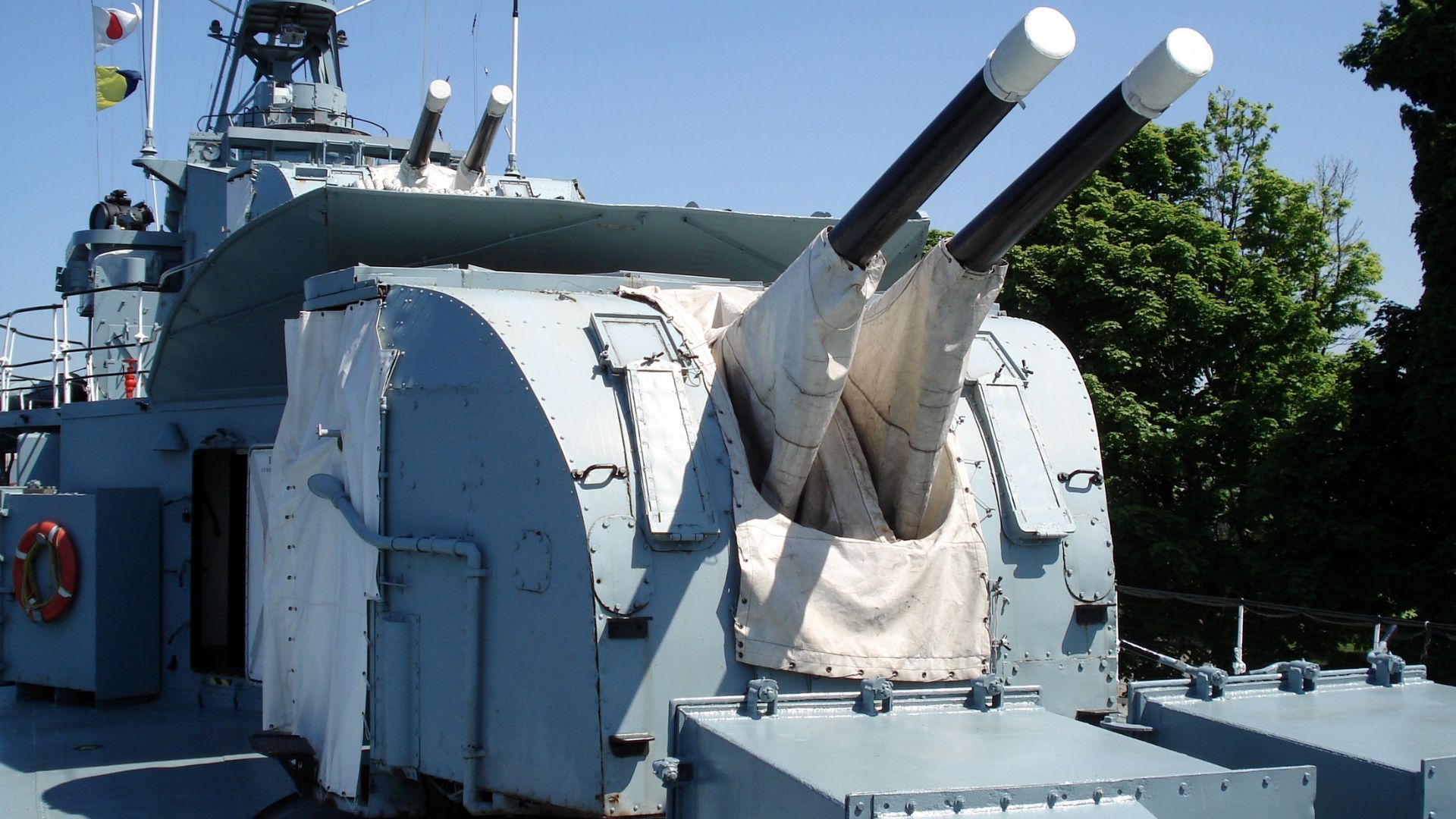
Cannon Marine 4-inch (102 mm) Mark XVI (British designation - 4-inch L/45 QF HA Marks XVI, in a nutshell, Mk. XVI) – British Sea universal gun caliber 102 mm from the 30s Twentieth century, occurring primarily in the conjugated double version from Mark XIX. It was the most numerous medium-caliber gun on British ships during World War II and was also used in some Allied vessels.
QF 4 Inch Mk Xvi Naval Gun History
The new cannon universal 102 mm Mark XVI was developed around 1934 and was introduced into service in 1936. It replaced the old anti-aircraft gun of this caliber 4in L/45 QF Mark V, a single base. In contrast, Mark XVI was primarily intended for use as a double-coupled. After some time, has developed an improved design barrel (barrel samowzmacniana, mantle), marked by Mark XVI * (originally Mark XVIII). The new version has become the standard, and previous work Mark XVI brought to an understanding of Mark XVI * during repairs (generally in the literature of both versions is defined simply as the Mark XVI).
British designation: 4-inch L/45 QF HA Marks XVI meant 4-inch caliber gun with a long barrel 45 calibers, ammunition merged with crimped metal (QF – Ouick Firing), anti-air (HA – High angle), model XVI.
Gun Mk. XVI was particularly well fitted for defense at greater distances, but using surface ships against targets was considered a disadvantage because relatively low-mass projectiles were less effective than those commonly used on the destroyer's department of the period of 120 mm.
Partially compensated by the rate of fire. In addition, it had a high accuracy. However, it is considered to be one of the most successful department universals. Has been used for many types of British ships, the figure would be even higher, but the production department failed to cover the great demand for them in the first half of World War II.
Manufactured to the first years after the war, about 2555 guns Mk. XVI and Mk. XVI * in the UK, 504 in Canada, and 45 in Australia. They were used in some jackets for several decades after the war.
There were also two related model forums - Mk.XVII, with reduced weight for a heavy cruiser County (built 12 guns, then converted to Mk. XVI), and a new lighter version of the Mk.XXI (with samowzmacnianą barrel monobloc). Cannons Mk. XXI made 238 units in the UK, and 135 in Canada used them on the frigates.
QF 4 Inch Mk Xvi Naval Gun Application
The cannon on the basis of Mk. XIX hit the most British battleships modernized in the 30s and most cruisers as well as auxiliary equipment for newly built destroyer escorts, poles, some frigates, and many other ships as the main armament.
Cannon Mark XVI for the Mark XIX was used on ships (the list is not exhaustive):
As Auxiliary Equipment
•HMS “Hood”
•HMS “Rodney”
•HMS “Barham”, HMS Malaya, HMS Warspite
•Battleship Revenge
•A heavy cruiser County
•HMS “Exeter”
•A light cruiser Swiftsure
• Colony-type light cruisers
•A light cruiser, Edinburgh
•A light cruiser Southampton (Town)
•A light cruiser, Arethusa
•A light cruiser, Perth
•A light cruiser, Leander
•HMS “Effingham”
•HMS “Danae” (ORP “Conrad”)
•Tribal destroyers type
Description
102 mm caliber cannon, firing ammunition Nomenclature odtylcowo charged. Threaded barrel, mantle, samowzmacniana (Mark XVI *). Castle V, semi-automatic, open down, closed manually. Ammunition is loaded manually. Has been guided by hand (some at the end of the war received an electric drive). Life barrel was about 600 shots.
Works Mk. XVI assembled primarily two on a standard platform trailer, raised together in dual positions Mk. XIX, sheltered from the front and partly from the top and sides of the mask Shrapnel (półwieżach). Several variations of masks looked slightly different in the rear part. Weight półwieży Mk. XIX was 16.8 t
In a much smaller number of individual positions, Mk Mk XX and XXIV (the latter, for the guns Mk. Weight position Mk. XX – 10 t, Mk. XXIV – 8.63 t.
Used Two Types Of Missiles
•Explosive (HE)
•Piercing (SAP)
•Shrapnel
•Lighting
General Characteristics
•Caliber - 102 mm
•Cannon length - 4839 cm
•Barrel length - 4572 cm (L/45)
•Breech size - 8,387 dm3
•Elevation angle - 10 ° to +80 °
•Rate of 15-20 rounds/min
•Mass cannon - 2395 kg
•HE cartridge weight - 28.8 kg
•SAP cartridge weight - 30.28 kg
•HE shell weight - 15.88 kg
•SAP bullet weight - 17.35 kg
•Cartridge length - 114.6 cm